Introduction
Viburnums are plants in the genus Viburnum, with about 150 species, occupying most of the temperate regions of the Northern Hemisphere and some tropical montane regions of South America, Africa, and southeast Asia (Anonymous 2005a, 2005b). Florida has five native species of viburnums including Viburnum acerifolium, Viburnum dentatum, Viburnum rufidulum, Viburnum obovatum, and Viburnum nudum. Several species of viburnum with showy flowers and berries are popular as garden or landscape plants.
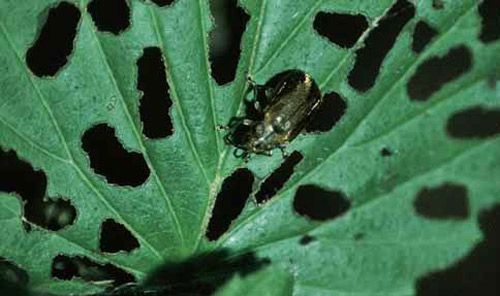
Credit: Paul Weston, Cornell University, www.forestryimages.org. UGA1300037
A leaf beetle, Pyrrhalta viburni (Paykull), commonly known as the viburnum leaf beetle (VLB) particularly attacks viburnums (Weston and Hoebeke 2003a). This beetle, which is native to Europe and Asia, was first detected in North America in 1947 in Ontario, Canada, but established breeding populations were noticed only in 1978 in the Ottawa/Hull region of Canada (Becker 1979). The VLB slowly spread in the region, and was discovered later in Maine (1994) and New York State (1996) (Weston and Hoebeke 2003a). Subsequently it expanded its range towards the east and south, and given its host range diversity, it may become widespread.
Distribution
The viburnum leaf beetle (VLB) is distributed throughout eastern Canada and the northeastern United States, including parts of Maine, New Hampshire, Vermont, New York, Pennsylvania, Ohio, and most recently in Washington (Murray 2005, Weston and Hoebeke 2003). Although it is rapidly spreading southward, studies indicate that the southern range expansion might be limited by mild winters. VLB eggs require a prolonged chilling period (Weston and Diaz 2005).
Description
Adult
The viburnum leaf beetle is approximately 4.5 to 6.5 mm (~ 1/5 to 1/4 inch) in length. The head, thorax, and elytra are generally brown, and the anterior edge of the elytra is slightly dark. The dorsal surface is covered with dense golden-grey hair (Weston and Hoebeke 2003a). In overall appearance, VLB resembles the elm leaf beetle (Pyrrhalta luteola Müller) except for minor differences in size and color. Generally, the elm leaf beetle is slightly larger with a body length of 5.8 to 6.8 mm (~1/4 inch). In addition, the elm leaf beetle has a light brown body with a dark stripe on the edge of each forewing, almost reaching the apex (tip of wing) (Becker 1979, Wheeler and Hoebeke 1994).
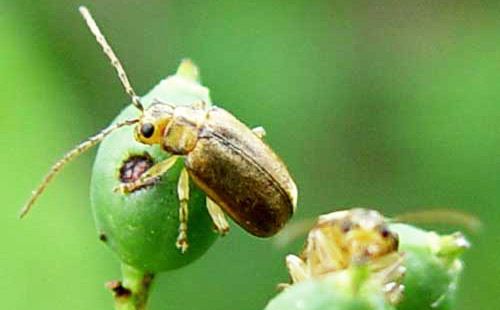
Credit: Paul Weston, Cornell University, www.forestryimages.org. UGA9005048
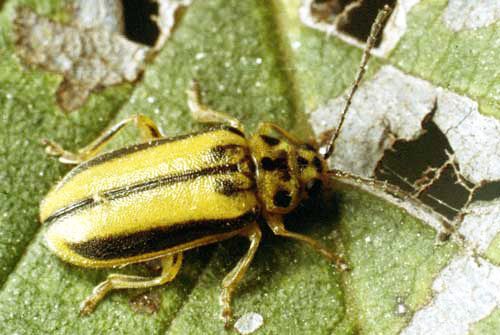
Credit: Paul Weston, Cornell University, www.forestryimages.org, UGA9005044
Larva
Newly hatched larva is greenish yellow and very small (~1-2 mm or 1/25 to 1/15 inch). As it grows, a pattern of dark spots develops on the body and make it appear dark (Murray 2005). Mature larva is 10 to 11 mm (2/5 inch) long, slightly depressed, and sub-cylindrical.
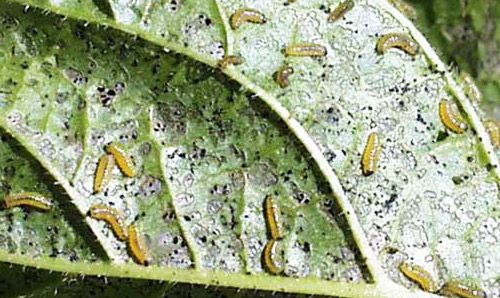
Credit: Paul Weston, Cornell University, www.forestryimages.org, UGA9005046
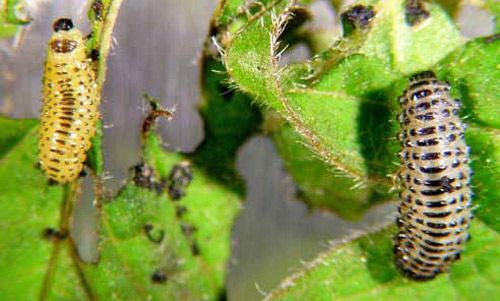
Credit: Paul Weston, Cornell University, www.forestryimages.org, UGA9005045
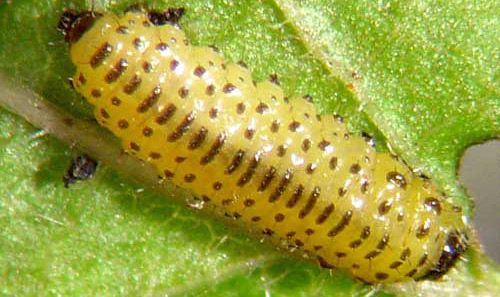
Credit: Paul Weston, Cornell University, www.forestryimages.org, UGA9005046
Life Cycle
The viburnum leaf beetle overwinters as eggs and requires a chilling period of approximately five months (Weston and Diaz 2005). They hatch around May when leaf buds open. Larvae pass through three developmental stages (instars). attaining a length of 10 to 11 mm (~2/5 inch) at maturity. Weston and Diaz (2005) who studied the effect of temperature on the development of immature stages found out that larval development is fast in the temperature range 63–72°F (17–22°C) and levels off at 81°F (27°C). The matured larvae enter the soil to pupate from early to mid-June and emerge as adults in July. The pupal stage lasts for about 10 days (Murray 2005).
Adult females lay eggs from late June to October or until the first killing frost (Weston and Cramer 2006). During its life span, the adult female lays up to 500 eggs on viburnum twigs and small branches by excavating deep, rounded, pinhead-sized egg cavities in a straight row on the under surface of the terminal twigs. After filling the egg cavity with five to eight eggs, the female closes the opening with a lid or "cap" made of excrement and chewed bark held together by a mucous secretion that hardens upon exposure. The cap not only protects the egg from predation, but also absorbs water to maintain the humidity.

Credit: Paul Weston, Cornell University, www.forestryimages.org, UGA9005049
The development period from egg hatch to adult emergence lasts eight to ten weeks (Becker 1979) but P. viburni completes only one generation a year.
Hosts
Adults and larvae of VLB feed almost exclusively on species of viburnum (Wheeler and Hoebeke 1994). It has strong preference for arrowwood viburnum (Viburnum dentatum), European cranberry bush viburnum (Viburnum opulus), and Rafinesque viburnum (Viburnum rafinesquianum). Other species of viburnums include Sardent viburnum (Viburnum sargentii), wayfaring tree viburnum (Viburnum lantana), nannyberry viburnum (Viburnum lentago), and blackhaw viburnum (Viburnum prunifolium). In a summary of the findings of the Viburnum Leaf Beetle Citizen Science Project 2003, Weston (2003) categorized commonly grown viburnums into most susceptible, moderately susceptible and resistant species. The project aimed at monitoring the spread and damage of VLB in New York by involving knowledgeable and motivated citizens in meaningful scientific research program. Participants included landscapers, master gardeners, garden clubs, and school classes.
The study provided these results:
Most susceptible to VLB:
Viburnum opulus/trilobum—European cranberry bush viburnum
Viburnum dentatum—arrowwood viburnum
Viburnum sargentii—Sardent viburnum
Moderately susceptible to VLB:
Viburnum acerifolium
Viburnum carlcephalum
Viburnum lantana—wayfaring tree viburnum
Viburnum lentago—nannyberry viburnum
Viburnum macrocephalum
Viburnum pragense
Viburnum prunifolium—blackthorn viburnum
Resistant to VLB:
Viburnum burkwoodii
Viburnum carlesii
Viburnum lantanoides/alnifolium
Viburnum plicatum f. tomentosum
Viburnum rhytidiophylloides
Viburnum rhytidiophyllum
Viburnum sieboldi
Damage
Adults and larvae feed between the midrib and larger veins and skeletonize the leaves. Adult beetles chew oblong shot holes into the leaves. Young larvae feed together on the underside of the young and tender leaves. Heavy infestations cause defoliation, and plants continuously defoliated for two to three consecutive years may be killed (Young 2004, Ventresca and Kessel 2000).
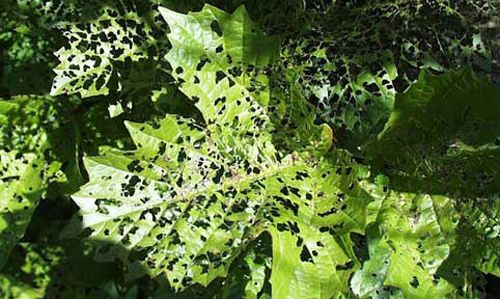
Credit: Paul Weston, Cornell University, www.forestryimages.org, UGA9005050
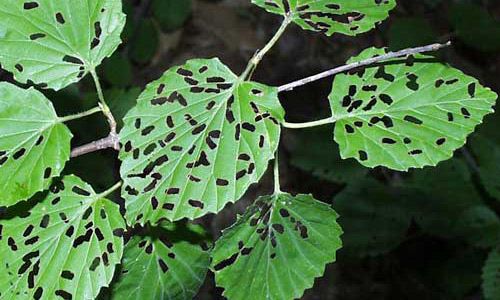
Credit: Paul Weston, Cornell University, www.forestryimages.org, UGA9005047
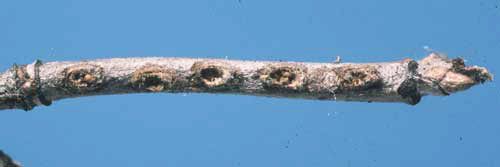
Credit: Paul Weston, Cornell University, www.forestryimages.org, UGA1300014
Management
Mechanical Control
The best management option for VLB is to prune and destroy the infested twigs and branches during the winter. It is best to start monitoring for eggs after the first frost in the fall or winter. Egg laying sites are easy to spot when leaves are shed. Twigs with egg scars should be pruned off and destroyed from October through early May (Weston and Cramer 2006).
On a small scale, the adult beetles can also be collected and destroyed. VLB readily drop to the ground when disturbed, and they can be collected in a soapy water by knocking the adults off the branches with a gentle tap (Ventresca and Kessel 2000, Weston and Cramer 2006). Repeated collections may be necessary as the beetles are likely to migrate from other infested areas.
When the VLB larva is ready to pupate in the soil, it crawls down the plant instead of directly dropping to the ground from the leaves. Trapping the larva with sticky barrier around the base is also suggested (Weston and Cramer 2006).
Cultural Control
Use of species or cultivars less susceptible to VLB may also reduce the severity of infestation. Some of the resistant species of viburnum include Viburnum burkwoodii, Viburnum carlesii, Viburnum lantanoides/alnifolium, Viburnum plicatum f. tomentosum, Viburnum rhytidiophylloides, Viburnum rhytidiophyllum, and Viburnum sieboldi (Weston 2003).
Biological Control
Predaceous insects like the larvae and adults of multicolored Asian lady beetle, larvae of lacewings, and spined soldier bugs eat larvae and adults of VLB, and these beneficial insects are commercially available for purchase (Weston and Cramer 2006).
Chemical Control
Soil application of systemic insecticides is also known to be effective (Weston and Cramer 2006) but the use of many systemic insecticides is restricted. Contact your local Cooperative Extension Service office for more information.
If pruning, as described in mechanical control above, is impractical, insecticides may be sprayed when the larvae first appear in May. However, spraying against adults alone is considered ineffective as a control strategy (Weston and Hoebeke 2003b, Weston 2003).
Selected References
Becker EC. 1979. Pyrrhalta viburni (Coleoptera: Chrysomelidae), a Eurasian pest of Viburnum recently established in Canada. The Canadian Entomologist 111: 417-419.
Brewer L, Cramer C. 2018. Viburnum Leaf Beetle. Cornell University. http://www.hort.cornell.edu/vlb/ (July 2020).
Murray T. (2005). Pest Alert! The Viburnum Leaf Beetle. Garden Friends and Foes. Washington State University. http://whatcom.wsu.edu/ag/homehort/pest/VLB.htm (13 January 2006).
Ventresca M, Kessel C. (2000). Viburnum Leaf Beetle (Coleoptera: Chrysomelidae). Fact Sheet, University of Guelph. http://www.ceris.purdue.edu/napis/pests/vlb/news/fs-vlb.html (January 9 2006).
Weston PA. (2003). Viburnum Leaf Beetle Citizen Science Project: Summary of 2003 findings. Cornell University. http://www.hort.cornell.edu/vlb/news/2003report.pdf (February 2016).
Weston PA. 2005. Viburnum Leaf Beetle: Update on a recently arrived landscape pest. Proceedings, 16th U.S. Department of Agriculture Interagency Research Forum on Gypsy Moth and other Invasive Species 2005. GTR-NE-337. https://www.fs.usda.gov/ne/newtown_square/publications/technical_reports/pdfs/2005/337papers/weston337.pdf (February 2023).
Weston PA, Diaz MD. 2005. Thermal requirements and development of immature stages of viburnum leaf beetle, Pyrrhalta viburni (Paykull) (Coleoptera: Chrysomelidae). Physiological Ecology 34: 985 â€" 989.
Weston PA, Cramer C. (2006). Viburnum Leaf Beetle Citizen Science: The Pest. Cornell University. (February 2016)
Weston PA, Hoebeke ER. 2003a. Viburnum leaf beetle, Pyrrhalta viburni (Paykull) (Coleoptera: Chrysomelidae): Dispersal pattern of a palearctic landscape pest in New York and its distribution status in the northeastern U.S. and eastern Canada. Proceedings of Entomological Society of Washington 105: 889-895.
Weston PA, Hoebeke ER. (2003b). Viburnum leaf beetle, Pyrrhalta viburni (Paykull), Fact Sheets, Cornell Cooperative Extension, Cornell University.
Wheeler AG Jr., Hoebeke ER. 1994. Proceedings of Entomological Society of Washington 96: 749-756.
Young CE. (2004). Ornamental Plants Annual Reports and Research Reviews 2004. Bulletin, Extension and Research. The Ohio State University.